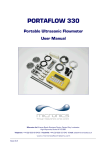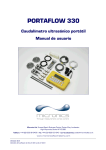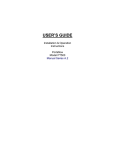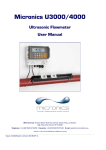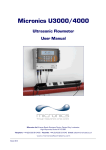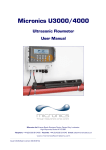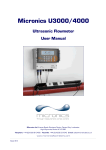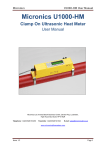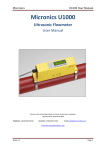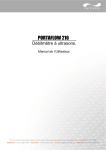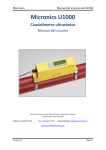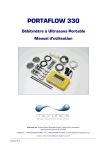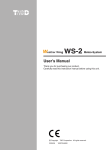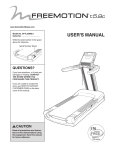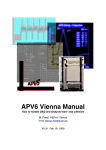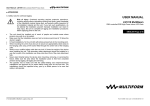Download PF440IP Portable Clamp On Ultrasonic Flow Meter User Manual
Transcript
PF440IP Portable Ultrasonic Flowmeter User Manual Micronics Ltd, Knaves Beech Business Centre, Davies Way, Loudwater, High Wycombe, Bucks HP10 9QR. Telephone: +44 (0)1628 810456 Facsimile: +44 (0)1628 531540 E-mail: [email protected] www.micronicsflowmeters.com Issue 1.0 (Software Ver. 02.10.007) Table of Contents 1: General Description 1 1.1 Introduction 1 1.2 Principles of Operation 2 1.3 Supplied Hardware 3 1.4 PF440IP Instrument 1.4.1 Connectors 1.4.2 Keypad 1.4.3 Power supply and battery charging 4 4 5 6 1.5 Transducers 6 2: Installation 7 2.1 Transducer Positioning 7 2.2 Transducer Attachment (Type ‘B’) 2.2.1 Preparation 2.2.2 Attaching the guide rails 2.2.3 Fitting the transducers 8 8 8 9 2.3 Installing the USB Virtual Com. Port 3: Operating Procedures 10 13 3.1 Setting-up the Instrument 3.1.1 Using the instrument for the first time 3.1.2 Enabling/disabling the backlight 14 14 15 3.2 Using the Quick Start Menu 15 3.3 Using the System at a Regularly Monitored Location 18 3.4 Managing Named Sites 3.4.1 Setting up a new site 3.4.2 Changing a site name 20 20 21 3.5 Instrument Calibration 3.5.1 Adjusting the zero cut-off 3.5.2 Adjusting the set zero flow offset 3.5.3 Adjusting the calibration factor 3.5.4 Adjusting the roughness factor 3.5.5 Adjusting the damping factor 22 22 22 23 24 25 3.6 Performing Monitoring & Logging Functions 3.6.1 How to measure totalised flows (manually) 3.6.2 Display of totalisers 3.6.3 How to set up the basic logging application to memory 3.6.4 How to set up automatic (timed) logging mode 25 26 27 27 29 Portaflow 440IP User Manual (Issue 1.0) (Software Ver. 02.10.007) i 3.6.5 Sleep mode 3.6.6 How to log directly to a PC 3.6.7 How to download logged data to a PC 31 32 32 3.7 Configuring the PF440IP Communication Interfaces 3.7.1 How to set-up a USB connection 3.7.2 Working With Portagraph III 33 33 33 3.8 Configuring the Current / Pulse Output 3.8.1 Current output 3.8.2 Pulse output 33 34 36 4: Maintenance & Repair 39 5: Troubleshooting 41 5.1 Overview 41 5.2 General Troubleshooting Procedure 42 5.3 Warning & Status Messages 43 5.4 Diagnostics Display 46 Appendix A: Specification 47 ii Portaflow 440IP User Manual (Issue 1.0) (Software Ver. 02.10.007) 1: General Description 1.1 Introduction This manual describes the operation of the Micronics PF440IP portable flowmeter. The flowmeter is designed to work with clamp-on transducers to enable the flow of a liquid within a closed pipe to be measured accurately without needing to insert any mechanical parts through the pipe wall or protrude into the flow system. Using ultrasonic transit time techniques, the PF440IP is controlled by a micro-processor system which contains a wide range of data that enables it to be used with pipes with an outside diameter ranging from 13mm up to 5000mm and constructed of almost any material. The instrument will also operate over a wide range of fluid temperatures. Easy to operate, the PF440IP standard features are: • • • • • • • • • • • Large, easy to read graphic display with backlighting. Simple to follow dual function keypad. Simple ‘Quick Start’ set up procedure. 200k stored data points. Continuous signal monitoring. USB output. Pulse output (volumetric or frequency). 4-20mA, 0-20mA or 0-16mA output. Rechargeable battery. Battery management. Diagnostics. Volumetric flow rates are displayed in l/h, l/min, l/sec, gal/min, gal/h, USgals/min, USgals/h, Barrel/h, Barrel/ day, m³/s, m³/min, m³/h. Linear velocity is displayed in metres or feet per second. When operating in the ‘Flow Reading’ mode the total volumes, both positive and negative, are displayed up to a maximum 12-digit number. The flowmeter can be used to measure clean liquids or oils that have less than 3% by volume of particulate content. Cloudy liquids such as river water and effluent can be measured along with cleaner liquids such as demineralised water. Typical PF440IP applications include: • • • • • River water. Seawater. Potable water. Demineralised water. Treated water. Portaflow 440IP User Manual (Issue 1.0) (Software Ver. 02.10.007) 1 1: General Description 1.2 Principles of Operation When ultrasound is transmitted through a liquid the speed at which the sound travels through the liquid is accelerated slightly if it is transmitted in the same direction as the liquid flow and decelerated slightly if transmitted against it. The difference in time taken by the sound to travel the same distance but in opposite directions is therefore directly proportional to the flow velocity of the liquid. The PF440IP system employs two ultrasonic transducers attached to the pipe carrying the liquid and compares the time taken to transmit an ultrasound signal in each direction. If the sound characteristics of the fluid are known, the Portaflow microprocessor can use the results of the transit time calculations to compute the fluid flow velocity. Once the flow velocity is known the volumetric flow can be easily calculated for a given pipe diameter. The Portaflow system can be set up to operate in one of four modes determined mainly by the pipe diameter and the type of transducer set in use. The diagram below illustrates the importance of applying the correct separation distance between the transducers to obtain the strongest signal. Separation Distance Upstream transducer Reflex mode U This is the mode most commonly used. The two transducers (U & D) are attached to the pipe in line with each other and the signals passing between them are reflected by the opposite pipe wall. The separation distance is calculated by the instrument in response to entered data concerning the pipe and fluid characteristics. D Fluid flow Separation Distance Reflex mode (double bounce) U In this mode the separation distance is calculated to give a double bounce. This is most likely to occur if the pipe diameter is so small that the calculated reflex mode separation distance would be impractical for the transducers in use. D Fluid flow Separation Distance D U Fluid flow Separation Distance Reflex mode (triple bounce) This illustration goes one step further to show a triple bounce situation. This would normally apply when working with very small pipes relative to the transducer range in use. Diagonal mode This mode might be selected by the instrument where relatively large pipes are concerned. In this mode the transducers are located on opposite sides of the pipe but the separation distance is still critical in order for the signals to be received correctly. U Fluid flow This mode might be used with the standard ‘B’ transducer set on the larger pipe installation. D Figure 1.1 Operating modes 2 Portaflow 440IP User Manual (Issue 1.0) (Software Ver. 02.10.007) 1: General Description 1.3 Supplied Hardware The Portaflow equipment is supplied in a rugged IP67 carrying case fitted with a foam insert to give added protection for transportation. The supplied components are shown in Figure 1.2. A L B K J I C H G F E D Figure 1.2 Standard Portaflow equipment Standard equipment A: PF440IP instrument with backlit graphic display. B: Equipment carrying bag. C: Ruled separation bar (2-piece). D: Power supply – with UK, US, European adaptors. 110/240VAC. E: Transducer set ‘B’ (x2) – immersible type. F: Tape measure. G: Set of guide rails for use with transducer mounting. H: Ultrasonic couplant and applicator. I: 4-20mA/Pulse Output cable and USB cable. J: 2 lengths of chain each at 3.3 metres long. K: USB interface cable. L: Transducer cables (x2) – immersible type. Manual. Portaflow 440IP User Manual (Issue 1.0) (Software Ver. 02.10.007) 3 1: General Description 1.4 PF440IP Instrument The PF440IP is a microprocessor controlled instrument operated through a menu system using an inbuilt LCD display and keypad. It can be used to display the instantaneous fluid flow rate or velocity, together with totalised values, or act as a data logger. When operating in the data logger mode the logged data can be output directly to a PC or printer using the USB interface or stored in the instrument’s non-volatile memory for downloading at a later time. Up to 98k logging events can be stored internally. The instrument can also provide a variable current or variable ‘pulse’ (volumetric or frequency) output that is proportional to the detected flow rate. This output can be calibrated to suit a particular flow range and used with a range of external interface devices, such as those found in BMS or site monitoring systems. 1.4.1 Connectors Logging Active led Pulse/4-20-mA Output USB Output Battery charger Downstream transducer Upstream transducer Figure 1.3 Instrument connections Transducer connections The transducer cables are connected to two metal TNC connectors located on the side of the enclosure. For a positive flow reading the sensors must be connected as indicated on the side panel. If the flow reading is negative, reverse the connections. It is safe to connect or disconnect the cables while the instrument is switched on. USB connection A USB cable is included as part of the PF440IP kit. This can be connected to the USB socket on the side of the enclosure. 4-20mA and Pulse output connection The 4-20mA / ‘pulse’ output cable should be connected to the Pusle and 4-20mA connector on the side of the instrument A single cable that can be adapted for use for either of these output functions is included in the PF440IP kit. The ‘tails’ on the free end of the cable must be terminated to suit the intended application. Red – 4-20mA positive Black – 4-20mA negative White – Pulse output Green – Pulse return Thick Black – Cable screen Battery charger connection The supplied battery charger is connected to the instrument by means of the centre connector on the side of the unit, as shown in Figure 1.3. 4 Portaflow 440IP User Manual (Issue 1.0) (Software Ver. 02.10.007) 1: General Description 1.4.2 Keypad Numerical keypad with dual function keys ON/OFF Scroll UP ENTER (SELECT) Scroll DOWN Scroll LEFT Scroll RIGHT Figure 1.4 Keypad The instrument is configured and controlled via a 16-key tactile membrane keypad, as shown in Figure 1.4. ON/OFF Key The ON/OFF key is shown on the bottom left of the keypad. When turned ON an initialisation screen is displayed on the LCD showing the instrument’s serial number and software revision. Once this appears, the instrument can be started by pressing the ENTER key once – the initialization screen is then replaced by a MAIN MENU which provides access to the remaining functions. Menus and the menu selection keys The PF440IP menus are arranged hierarchally with the MAIN MENU being at the top level. Menu navigation is achieved by three keys on the right hand side of the keypad which are used to scroll UP and DOWN a menu list and SELECT a menu item. When scrolling through a menu an arrow-shaped cursor moves up and down the left hand side of the screen to indicate the active menu choice which can then be selected by pressing the ENTER (SELECT) key. Some menus have more options than can be shown on the screen at the same time, in which case the ‘overflowed’ choices can be brought into view by continuing to scroll DOWN past the bottom visible item. Menus generally ‘loop around’ if you scroll beyond the first or last items. If you select Exit it usually results in taking you back one level in the menu hierarchy, but in some cases it may go directly to the ‘Flow Reading’ screen. Some screens require you to move the cursor left and right along the display as well as up and down. This is achieved using keys 5 (scroll LEFT) and 6 (scroll RIGHT). Dual function numerical keypad The block of keys shown in the centre of the keypad in Figure 1.4 are dual function keys. They can be used to enter straight-forward numerical data, select the displayed flow units or provide quick access to frequently required control menus. Portaflow 440IP User Manual (Issue 1.0) (Software Ver. 02.10.007) 5 1: General Description 1.4.3 Power supply and battery charging Operating power is provided by an internal battery that can be charged from the utility supply using the supplied external charger. When you first receive the unit you must put the battery on charge for a minimum of 10hrs before use. A fully charged battery will power the instrument for up to 50 hours depending on the output utilisation and backlight usage. To turn ON the unit: 1. Plug in the charger, then press the Power key. 2. Wait for the logo screen to be displayed, then press the Power key again. 3. The display will indicate that the charger is plugged in (small symbol on top line) and display Charging on the top line. Key Point: The charger must only be used in a dry environment. The IP67 rating of the enclosure applies only when using the internal battery power. The backlight can be selected to be either permanently OFF, illuminated for 10 seconds, 30 seconds or 1 minute every time a key is pressed, or permanently ON - as configured in the Setup Instrument menu. If the backlight is active continuously it will reduce the available battery operating time to 20hrs. Similarly, if the 420mA output is used constantly at 20mA, the battery life would reduce by 50%. It is therefore beneficial to turn off the backlight and 4-20mA output facilities when they are not required. When the instrument is operating in the 'Flow Reading' mode the percentage battery charge level is displayed symbolically on the LCD screen. A warning message is triggered if the charge falls to approximately 30%, at which point there is up to 12 hours of battery operation remaining, depending on usage. The battery can be charged both while the instrument is in use or when switched off. The instrument's internal data is stored in non-volatile memory and will not be lost even if the battery discharges completely. The battery life can be extended by using the Sleep Mode logging option. This powers down the instrument between readings and will give a battery life of about 200 hours logging at six minute intervals, and proportionally longer at larger intervals. Key Point: The battery is not a user-changeable item. The instrument must be returned to your distributor if the battery needs replacing. Key Point: Only use the supplied charger, or special adaptor lead. Failure to comply with this will invalidate your warranty. 1.5 Transducers The B type ultrasonic transducers supplied are for use on pipes with an outside diameter of 50 to 2000 mm. The recommended separation distance will be in the Reflex mode. On larger pipes it may be better to use the Diagonal mode instead. 6 Portaflow 440IP User Manual (Issue 1.0) (Software Ver. 02.10.007) 2: Installation 2.1 Transducer Positioning In many applications an even flow velocity profile over a full 360° is unattainable due, for example, to the presence of air turbulence at the top of the flow and possibly sludge in the bottom of the pipe. Experience has shown that the most consistently accurate results are achieved when the transducer guide rails are mounted at 45° with respect to the top of the pipe. The Portaflow equipment expects a uniform flow profile as a distorted flow will produce unpredictable measurement errors. Flow profile distortions can result from upstream disturbances such as bends, tees, valves, pumps and other similar obstructions. To ensure a uniform profile the transducers must be mounted far enough away from any cause of distortion such that it no longer has an effect. Uniform Flow Profile Air Distorted Flow Profile Guide rail 45° Possible sludge Flow 10 x Diameter Valid transducer location 20 x Diameter Flow Figure 2.1 Locating the transducers To obtain the most accurate results the condition of both the liquid and the pipe wall must be suitable to allow the ultrasound transmission along its predetermined path. It is important also that the liquid flows uniformly within the length of pipe being monitored and that the flow profile is not distorted by any upstream or downstream obstructions. This is best achieved by ensuring there is a straight length of pipe upstream of the transducers of at least 20 times the pipe diameter and 10 times the pipe diameter on the downstream side, as shown in Figure 2.1. Flow measurements can be made on shorter lengths of straight pipe, down to 10 diameters upstream and 5 diameters downstream, but when the transducers are positioned this close to any obstruction the resulting errors can be unpredictable. Key Point: Do not expect to obtain accurate results if the transducers are positioned close to any obstructions that distort the uniformity of the flow profile. Micronics Limited accepts no responsibility or liability if product has not been installed in accordance with the installation instructions applicable to the product. Portaflow 440IP User Manual (Issue 1.0) (Software Ver. 02.10.007) 7 2: Installation 2.2 Transducer Attachment (Type ‘B’) Type ‘B’ transducers are fitted to adjustable guide rails which are secured to the pipe using wrap-around chains and mechanically connected together by a steel separation bar. The separation bar also acts as a ruler to allow the distance between the transducers to be accurately set to the value determined by the Portaflow instrument. When fitting the guide rails it is easiest to assemble them onto the separation bar and adjust to the required separation distance before attaching them to the pipe. 2.2.1 Preparation 1. Before you attach the transducers you should first ensure that the proposed location satisfies the distance requirements shown in Figure 2.1 otherwise the resulting accuracy of the flow readings may be affected. 2. Prepare the pipe by degreasing it and removing any loose material, or flaking paint, in order to obtain the best possible surface. A smooth contact between the pipe surface and the face of the transducers is an important factor in achieving a good ultrasound signal strength and therefore maximum accuracy. 2.2.2 Attaching the guide rails A B C D E F G A: Tensioning thumb-wheel. B: Tension bar. C: Separation bar securing screw. D: Separation bar. E: Ruler scale (0). F: Set Separation distance. G: Securing chain. Figure 2.2 Guide rail attachment 8 1. Slide the separation bar (D) into the front of the left hand guide rail, align the front edge of the guide rail with ‘0’ on the ruler scale (E) and secure it in place by tightening the guide rail thumbscrew (C). 2. Slide the other end of the separation bar into the front of the right hand guide rail. Position the front edge of the guide rail at the required separation distance (obtained from the Portaflow instrument) on the ruler (F), then secure the guide rail in place by tightening the thumbscrew. Portaflow 440IP User Manual (Issue 1.0) (Software Ver. 02.10.007) 2: Installation 3. On each guide rail, attach one end of a securing chain to a hook on the tensioning bar (B), wrap the chain around the pipe (G) and then attach it to the hook on the other end of the tensioning bar whilst keeping the chain as tight as possible. 4. Rotate the complete guide rail assembly so that it is approximately 45° with respect to the top of the pipe, then tighten the chain by turning the tensioning thumb-wheel (A) on each guide block until the assembly is securely attached to the pipe. Note: If you are unable to get sufficient tension on the chain to hold the assembly in place, fully slacken the tensioning thumb-wheel (A) and shorten the effective length of the chain wrapped around the pipe by connecting the tensioning bar to the next link in the chain, then re-tension. 2.2.3 Fitting the transducers A: Transducer locating lug. B: Transducer lead connection. C: Transducer cover plate securing screw. D: Ultrasonic couplant application. E: Transducer cover plate. Figure 2.3 Fitting the transducers 1. Slide the transducer cover plate (E) fully towards the outside of the guide rail assembly to allow sufficient access to fit the transducer. 2. Clean the face of the transducer, removing all traces of dirt and grease. 3. Apply a 3mm bead of ultrasonic couplant along the centre length of the transducer face (D). 4. Feed the transducer lead through the guide rail from the rear and attach it to the transducer by screwing in the TNC connector. (B) 5. Fit the transducer into the guide block – ensuring the lugs on the sides of the transducer (A) are correctly located into the slots on the sides of the guide block (F). 6. Slide the transducer cover plate (C) over the top of the transducer until the transducer cover plate securing screw (C) aligns with the indentation on the top of the transducer, then tighten the screw finger tight to secure the transducer in place. 7. Repeat the above steps for the second transducer. The completed assembly is shown in Figure 2.4. Portaflow 440IP User Manual (Issue 1.0) (Software Ver. 02.10.007) 9 2: Installation Downstream transducer Upstream transducer Figure 2.4 Completed transducer assembly 8. 2.3 Connect the transducers to the Portaflow instrument using the coaxial cables provided. The illustration above shows the red sleeved lead connected to the upstream transducer and the blue lead to the downstream transducer. To measure a positive flow, connect the leads to the approriate upstream and downstream TNC connectors on the side of the instrument – see Figure 1.3. Installing the USB Virtual Com. Port If you have the CD supplied with the instrument then the USB drivers are included. Refer to the installation instructions for Portagraph III on the CD. If you do not have the CD then follow the instructions below. The USB connection requires a virtual com port to be installed on the computer. The necessary driver can be provided by Micronics or downloaded from http://www.ftdichip.com/Drivers/VCP.htm. 1. Access the above url and download the driver for your particular operating system. The download takes the form of a zip file. 2. Extract all the files from the zip file into a folder and note its location (e.g. Desktop\USBDriver). 3. Switch ON the PF440IP instrument and connect it to the USB port on the PC. 4. A “New device found” message will appear and ask you for the location of the software installation files for the new device. 5. Use the Browse button to select the path to the unzipped driver files and then click OK. 6. Follow the on-screen instructions to install the driver. 7. At the end of the driver installation routine you must carry out a minor configuration change to the newly installed virtual com port. The way in which you gain access to the com port set-up window will vary depending on your operating system. The following example applies to Windows XP. 8. Select Control Panel>System to open the SYSTEM PROPERTIES window. 9. Click the Device Manager button to open the DEVICE MANAGER window. 10. Scroll down to the Ports region and you will find the new FDTI port installed (e.g. USB Serial Port with a high port number). 11. Right-click on the com port and select Properties. 12. From the PROPERTIES window select the Port Settings tab then click the Advanced button. The ADVANCED SETTINGS window should open similar to that shown below. 10 Portaflow 440IP User Manual (Issue 1.0) (Software Ver. 02.10.007) 2: Installation Figure 2.5 Com. Port configuration 13. In the BM Options area change the Latency Timer value from 16 msec (default) to 1 msec. 14. Select OK to implement the change, and then close the remaining windows that were opened. 15. Your computer should now be able to communicate with the PF440IP instrument via the USB port in the same way as any other standard USB device. Portaflow 440IP User Manual (Issue 1.0) (Software Ver. 02.10.007) 11 2: Installation 12 Portaflow 440IP User Manual (Issue 1.0) (Software Ver. 02.10.007) 3: Operating Procedures Initial instrument setup (Paragraph 3.1) Battery charging, Set date/time, Language, Backlight Connect and take basic flow readings At a one-off location At a frequent location Manage site details (Paragraph 3.2) (Paragraph 3.3) (Paragraph 3.4) QUICK START VIEW EDIT SITE DATA Set up a named site Enter data Choose site / check/edit data Attach sensors Attach sensors FLOW READING FLOW READING Rename a site Carry out any necessary calibration (Paragraph 3.5) How to adjust the Zero Flow Offset – Paragraph 3.5.2 How to adjust the Calibration Factor – Paragraph 3.5.3 How to adjust the Roughness Factor – Paragraph 3.5.4 How to adjust the Damping Factor – Paragraph 3.5.5 Set-up a monitoring or logging application Configure the interfaces/Outputs (Paragraph 3.6) (Paragraph 3.7) (Paragraph 3.8) How to measure totalised flows – Paragraph 3.6.1 USB set-up – Paragraph 3.7.1 How to set up basic (manual) logging – Paragraph 3.6.3 4-20mA ON/OFF – page 34 How to set up auto-timed logging – Paragraph 3.6.4 4-20mA Calibration – page 34 How to set up logging ‘live’ to a PC – Paragraph 3.6.6 Pulse ON/OFF – page 36 How to download saved data to a PC – Paragraph 3.6.7 Pulse calibration – page 37 Pulse frequency mode – page 37 Pulse frequency calibration – page 37 Portaflow 440IP User Manual (Issue 1.0) (Software Ver. 02.10.007) 13 3: Operating Procedures 3.1 Setting-up the Instrument 3.1.1 Using the instrument for the first time Before you use your PF440IP for the first time you should first charge the battery, then select the display language and set-up the internal clock, as described below. Charging the battery 1. Connect the external battery charger to the charger socket at the bottom of the instrument then switch on the utility supply. 2. The instrument should indicate CHARGING and an animated battery symbol indicates that the battery is taking on charge. 3. Leave the instrument on charge for 10 hours before using it for the first time. CHARGING DD-MM-YY HH:MM:SS Selecting a language The first time you switch on the instrument you may be asked to select a user language. 1. Switch on the instrument by pressing the ON/OFF button. 2. If necessary, select the required language using the UP/DOWN scroll keys then press the ENTER key. 3. The selected language will be the default when the instrument is next used. To change the language again select the Change Language option in the SETUP INSTRUMENT screen (see below) 4. The initialisation screen will be displayed, giving details of the instrument’s serial number and software revision details. 5. Press the ENTER key to start the instrument. 6. This is the MAIN MENU and is the starting point for all the operations described in this chapter. Serial# 0012345 Press V 00.00.000 to start DD-MM-YY MAIN MENU HH:MM:SS Quick start View/Edit Site Data Data Logger Setup USB Setup Instrument Read flow Setting the Date & Time 1. 14 Select Setup Instrument from the MAIN MENU. The screen shown here should be displayed. 2. Select Set Date & Time and click ENTER. 3. A flashing cursor should appear under the first date number. Enter the date sequence in dd-mm-yy order then press the ENTER key. 4. Repeat this action to set the time. 5. Select Exit then press the ENTER key to return to the MAIN MENU. SETUP INSTRUMENT DD-MM-YY HH:MM:SS Set Date & Time : dd-mm-yy hh:mm:ss Calibrate 4-20mA Pulse output Backlight : Disabled Factory settings Change Language Exit Portaflow 440IP User Manual (Issue 1.0) (Software Ver. 02.10.007) 3: Operating Procedures Note: If you make a mistake when entering the data press the Delete key to move the cursor back to the number you wish to change, then continue. If you enter an invalid number an ‘ERR:Invalid Date or Time!’ error message is displayed on the second line of the screen. If this occurs repeat the set date/time procedure. 3.1.2 Enabling/disabling the backlight The backlight can be selected to be either Disabled, illuminated for 10 seconds, 30 seconds or 1 minute every time a key is pressed, or ON permanently. If the backlight is not required it is recommended that you disable it to prolong the battery discharge time. 1. Select Setup Instrument from the MAIN MENU. 2. Select Backlight from the SETUP INSTRUMENT screen then press the ENTER key. SETUP INSTRUMENT DD-MM-YY HH:MM:SS Set Date & Time : dd-mm-yy hh:mm:ss Calibrate 4-20mA Pulse output Backlight : Disabled Factory settings Change Language Exit 3.2 3. Select the required backlight operation. 4. Press the ENTER key to return to the SETUP INSTRUMENT screen. 5. Select Exit then press the ENTER key to return to the MAIN MENU. BACKLIGHT DD-MM-YY HH:MM:SS Disabled 10 seconds 30 seconds 1 minute ON Permanently Using the Quick Start Menu If you want to perform a ‘one-off’ flow reading at a particular pipe location the Quick Start menu provides the quickest way to set up the Portaflow system and access the FLOW READING screen. If the point at which you intend to take the measurement is likely to require regular monitoring it is best to set it up as a ‘Site’ within the PF440IP, which then stores the site parameters (See Paragraph 3.4). Before you can use the Portaflow system you need to obtain the following details (this information will be required when setting up the Quick Start menu): • • • • • The pipe outside diameter. The pipe wall thickness and material. The pipe lining thickness and material. The type of fluid. The fluid temperature. Entering the site data 1. Select Quick Start from the MAIN MENU and press the ENTER key. You will then be presented with a series of screens in which to enter the data mentioned above. 2. Select the dimension units (millimetres or inches) used to measure the pipe, then press the ENTER key. DIMENSION UNIT DD-MM-YY HH:MM:SS Select the dimension units: ➥mm Inches Portaflow 440IP User Manual (Issue 1.0) (Software Ver. 02.10.007) 15 3: Operating Procedures 3. Enter the pipe outside diameter dimension, then press the ENTER key. OUTSIDE DIAMETER DD-MM-YY Dimension: mm Pipe outside diameter? 4. Enter the pipe wall thickness dimension, then press the ENTER key. PIPE WALL THICKNESS 58.0 DD-MM-YY Dimension: If the pipe has a lining, enter the lining thickness. If nothing is entered the instrument automatically assumes there is no lining. 6. Press the ENTER key to continue. 7. Select the pipe wall material from the list provided, then press the ENTER key. If the material is not listed select Other and enter the propagation rate of the pipe wall material in metres/sec. Contact Micronics if this is not known. HH:MM:SS mm Pipe outside diameter? Pipe wall thickness? 5. HH:MM:SS PIPE LINING THICKNESS 58.0 4.0 DD-MM-YY Dimension: HH:MM:SS mm Pipe outside diameter? Pipe wall thickness? Pipe lining thickness? PIPE WALL MATERIAL 58.0 4.0 0.0 DD-MM-YY HH:MM:SS Select pipe wall material Mild Steel S' less Steel 316 S' less Steel 303 Plastic Cast Iron Ductile Iron Copper Brass Concrete Glass Other (m/s) 8. 9. If a lining thickness value was entered earlier, this screen is displayed to request that you enter the lining material type. If no lining thickness was entered this screen will be bypassed. Select the lining material from the list provided then press the ENTER key. If the material is not listed select Other and enter the propagation rate of the lining material in metres/sec. Contact Micronics if this is not known. 16 PIPE LINING MATERIAL DD-MM-YY HH:MM:SS Select pipe lining material Steel Rubber Glass Epoxy Concrete Other (m/s) Portaflow 440IP User Manual (Issue 1.0) (Software Ver. 02.10.007) 3: Operating Procedures 10. Select the fluid type from the list provided and press the ENTER key. If the liquid is not listed select Other and enter a propagation rate in metres/second. FLUID TYPE DD-MM-YY HH:MM:SS DD-MM-YY HH:MM:SS Select fluid type Water Glycol/water 50/50 Glycol/water 30/70 Lubricating oil Diesel Freon Other (m/s) 11. If you need to alter the fluid temperature from that shown select either °C or °F with the cursor and press the ENTER key. 12. Enter the new temperature value and press the ENTER key. 13. The new temperature should now be indicated in both °C and °F. FLUID TEMPERATURE Enter Fluid Temperature °C: 5.00 °F: 41.00 Continue.. 14. Select Continue.. then press the ENTER key. 15. The SENSOR SEPARATION screen now displays a summary of the entered parameters and informs you of the type of sensor to be used, the mode of operation and the distance to set up between the sensors. In this example it recommends type A-ST (A standard) sensors operating in the ‘Reflex’ mode spaced at 32.2mm apart. DD-MM-YY HH:MM:SS SENSOR SEPARATION Site : Quickstart Pipe : 58.00 mm Wall : 4.00 Sensors : A-ST Reflex Temperature : 10.00°C 50.00°F Set sensor separation to 32.2 mm Press to continue,UV to select sens. 16. Take a note of the displayed parameters, then press the ENTER key. ATTACH SENSORS 17. The ATTACH SENSORS screen displays, giving instructions to attach the sensors. DD-MM-YY HH:MM:SS Attach Sensor Set Press Red Connector UpStream key to go to Flow Reading Note: The SENSOR SELECTION menu can be entered by use of the Up/Down scroll keys. This allows the type and mode of the sensors being used to be selected. This menu will be entered automatically if the entered pipe OD and/or temperature are not valid for the currently selected sensors. Note: Do not press the ENTER key until the transducers are fitted and connected to the instrument. Attaching and connecting the transducers 18. Fit the designated sensors to the pipe using the appropriate guide rails as described in Paragraph 2.2. Take great care to set the separation distance as accurately as possible. 19. Connect the red and blue coaxial cables between the sensors and the test instrument, ensuring that the red connector on the instrument is connected to the ‘upstream’ sensor. Portaflow 440IP User Manual (Issue 1.0) (Software Ver. 02.10.007) 17 3: Operating Procedures Taking a flow reading 20. Once the transducers have been fitted and connected, press the ENTER key on the ATTACH SENSORS screen. 21. This will take you to the FLOW READING screen via a signal-checking screen (shown here). 22. Check that the indicated signal strength on the left of the screen is at least 2 bars (ideally 3 or 4). If less than 2 bars are shown it indicates there could be a problem with the transducer spacing, alignment or connections; or it could be due to an application problem. Please wait.. Checking signals **************************************** * * **************************************** FLOW READING Signal DD-MM-YY HH:MM:SS Qxx.xx% 0.000 +Total: 0.00 –Total: 0.00 l/min litres litres 23. Qxx.xx% indicates the signal quality and should have a value of 60% or greater. Flow monitoring The FLOW READING screen is the one most used during normal monitoring operation. It shows the instantaneous fluid flow together with totalised values (when enabled). In this mode you can select the flow rate measurement units by pressing keys 7 (litres), 8 (Gallons, Barrels) or 9 (m³), or change the display to show velocity by pressing key 4. If the flow reading exceeds a value of +/-9999 in the current units then a *10 multiplier will be displayed above the units and the value displayed will be a tenth of the actual value. Similarly a * 100 and *1000 may be displayed on very large flow rates. There are limitations on the use of these larger flow values with regards to logging of data and setting the current and pulse outputs. If the flow reading is less than 32000 m³/hour then the value can be logged and downloaded via Portagraph III. 3.3 Using the System at a Regularly Monitored Location Setting up the Portaflow system using the Quick Start method described in Paragraph 3.2 is easy and the recommended method to use in a ‘one-off’ situation. But if you have a site location that you want to monitor on a frequent basis it is better to set up a named ‘Site’ for that location so that you can recall it when needed and so avoid the need to re-enter the site details every time you want to install the equipment there. Note: See Paragraph 3.4 for details of how to set-up and manage site details. Use this procedure to install the equipment at a named site. 18 Portaflow 440IP User Manual (Issue 1.0) (Software Ver. 02.10.007) 3: Operating Procedures 1. Select View Edit Site Data from the MAIN MENU. 2. Select Choose from list of sites. 3. Select one of the sites listed and press the ENTER key. 4. The Site name will show the selected site and the site parameters will be listed on the screen. 5. Scroll down through the menu list and enter/ change the data that might have changed since the last time the site was accessed. 6. When you are satisfied that the parameters are correct select Save current site & read flow. VIEW EDIT SITE DATA DD-MM-YY HH:MM:SS Choose from list of sites Site name : MySite Dimensions : mm Pipe outside diameter: 58.00 Pipe wall thickness : 4.00 Pipe lining thickness: 0.00 Pipe wall material : Mild Steel Lining material : --------Sensor set : A-ST (see note) Sensor mode : Reflex Fluid type : Water Save current site & read flow Delete this Site Download & save current site Exit Note: If you select a different Sensor set (e.g. A-ST) when entering new site data you could receive an “invalid” error message if the previous Sensor set was operating at a temperature above 135ºC. If this occurs, ignore the warning as it will disappear when you enter a temperature in the correct range for new sensors. 7. If you need to alter the fluid temperature from that shown select either °C or °F with the cursor and press the ENTER key. 8. Enter the new temperature value and press the ENTER key. 9. The new temperature should now be indicated in both °C and °F. FLUID TEMPERATURE DD-MM-YY HH:MM:SS Enter Fluid Temperature °C: 5.00 °F: 41.00 Continue.. 10. Select Continue.. and then press the ENTER key. 11. The SENSOR SEPARATION screen now displays a summary of the entered parameters and informs you of the type of sensor to be used, the mode of operation and the distance to set up between the sensors. In this example it recommends type A-ST (A standard) sensors operating in the ‘Reflex’ mode spaced at 32.2mm apart. DD-MM-YY HH:MM:SS SENSOR SEPARATION Site : MySite Pipe : 58.00 mm Wall : 4.00 Sensors : A-ST Reflex Temperature : 10.00°C 50.00°F Set sensor separation to 32.2 mm Press to continue,UV to select sens. 12. Take a note of the displayed parameters, then press the ENTER key. ATTACH SENSORS 13. The ATTACH SENSORS screen displays, giving instructions to attach the sensors. (Software Ver. 02.10.007) HH:MM:SS Attach Sensor Set Press Portaflow 440IP User Manual (Issue 1.0) DD-MM-YY Red Connector UpStream key to go to Flow Reading 19 3: Operating Procedures Note: The SENSOR SELECTION menu can be entered by use of the Up/Down scroll keys. This allows the type and mode of the sensors being used to be selected. This menu will be entered automatically if the entered pipe OD and/or temperature are not valid for the currently selected sensors. Note: Do not press the ENTER key until the transducers are fitted and connected to the instrument. Attaching and connecting the transducers 14. Fit the designated sensors to the pipe using the appropriate guide rails as described in Paragraph 2.2. Take great care to set the separation distance as accurately as possible. 15. Connect the red and blue coaxial cables between the sensors and the test instrument, ensuring that the red connector on the instrument is connected to the ‘upstream’ sensor. Taking a flow reading 16. Once the transducers have been fitted and connected, press the ENTER key on the ATTACH SENSORS screen. 17. This will take you to the FLOW READING screen via a signal-checking screen (shown here). 18. Check that the indicated signal strength on the left of the screen is at least 2 bars (ideally 3 or 4). If less than 2 bars are shown it indicates there could be a problem with the transducer spacing, alignment or connections; or it could be due to an application problem. Please wait.. Checking signals **************************************** * * **************************************** FLOW READING Signal DD-MM-YY HH:MM:SS Qxx.xx% 0.000 +Total: 0.00 –Total: 0.00 l/min litres litres Flow monitoring The FLOW READING screen is the one most used during normal monitoring operation. It shows the instantaneous fluid flow together with totalised values (when enabled). In this mode you can select the flow rate measurement units by pressing keys 7 (litres), 8 (Gallons, Barrels) or 9 (m³), or change the display to show velocity by pressing key 4. 3.4 Managing Named Sites If you want to monitor a particular site location frequently you can set up a named ‘Site’ to store the installation details, such as pipe dimensions and material, required to set-up the PF440IP system. These can then be recalled later when revisiting that particular location. The instrument can store up to 20 sites, the first site is reserved for QUICK START and cannot be renamed; subsequent sites are initially named EmptySite1 through to EmptySite19. 3.4.1 Setting up a new site Key Point: Once you have set up a named site you are advised to log some data to the site in order to avoid the possibility of the site name being overwritten when the QuickStart data is saved. See Paragraph 3.6.3 for details. 20 Portaflow 440IP User Manual (Issue 1.0) (Software Ver. 02.10.007) 3: Operating Procedures VIEW EDIT SITE DATA 1. Select View Edit Site Data from the MAIN MENU. 2. Select Choose from list of sites. 3. Select one of the EmptySites from the presented list (e.g. EmptySite 1 as shown). 4. Select Site name and press the ENTER key. 5. This opens the ALTER NAME screen. ALTER NAME 6. Select Alter the Site Name and you will be presented with a screen which allows you to enter a new name in much the same way as when composing a mobile text message. Site name 7. On completion press the ENTER key then select Exit. This will take you back to the VIEW EDIT SITE DATA screen. 8. Scroll down through the menu list and enter/ change the pipe parameters and other data pertaining to the site. Note that this menu allows you to choose a Sensor Set, unlike the QUICK START menu which recommended the sensor set to use. If you enter an inappropriate sensor set in this menu you will be presented with an error message later when you go to the SENSOR SEPARATION screen. 9. When all the data is correct you can either: a) b) c) d) Select Save current site & read flow to continue fitting the transducers and opening the FLOW READING screen. Select Delete this site to delete the site name and values and restore it to the original EmptySite name. Select Download & save current site to save the site details and download them to a PC via USB provided the USB link is connected and correctly set-up. Select Exit to return to the MAIN MENU. DD-MM-YY HH:MM:SS Choose from list of sites Site name : EmptySite1 Dimensions : mm Pipe outside diameter: 58.00 Pipe wall thickness : 4.00 Pipe lining thickness: 0.00 DD-MM-YY HH:MM:SS : EmptySite1 Do you wish to:– Alter the Site Name Exit VIEW EDIT SITE DATA DD-MM-YY HH:MM:SS Choose from list of sites Site name : MyNewSite Dimensions : mm Pipe outside diameter: 58.00 Pipe wall thickness : 4.00 Pipe lining thickness: 0.00 Pipe wall material : Mild Steel Lining material : --------Sensor set : A-ST Sensor mode : Reflex Fluid type : Water Save current site & read flow Delete this Site Download & save current site Exit 3.4.2 Changing a site name To change a site name use the same method described above for generating a new site: but in this case access a current site name to change rather than an EmptySite. If you change a site name while the site is logging the logging will stop. Portaflow 440IP User Manual (Issue 1.0) (Software Ver. 02.10.007) 21 3: Operating Procedures 3.5 Instrument Calibration The Portaflow is fully calibrated before it leaves the factory; however the following adjustments are provided to allow you to further ‘fine tune’ your instrument to suit local conditions and application where necessary. Apart from the zero flow offset adjustment, these are normally carried out only where the instrument is to be used in a permanent or semi-permanent location. 3.5.1 Adjusting the zero cut-off This adjustment allows you to set a minimum flow rate (m/s) below which the instrument will indicate ‘0’. The default setting is 0.1 m/s but you may adjust this value if required. 1. With the instrument operating in FLOW READING mode, press the Options key to access the FLOW READING OPTIONS menu shown. 2. Select Zero Cutoff (m/s) and press the ENTER key. 3. Enter the value for the Zero Cutoff (e.g. 0.06 m/s) then press the ENTER key. 4. Scroll down to select Exit and press the ENTER key to return to the FLOW READING screen. FLOW READING OPTION Data review Zero Cutoff (m/s) Set zero flow (m/s) Damping (secs) Totaliser Reset +Total DD-MM-YY : : : : HH:MM:SS 0.00 0.00 10 Run 3.5.2 Adjusting the set zero flow offset The Portaflow instrument operates by comparing the time taken to send an ultrasonic signal between two transducers in either direction. A Set zero flow offset adjustment is provided to compensate for any inherent differences between the two sensors, noise pick-up, internal pipe conditions etc. It can be used to ‘zero’ the flow indication under no-flow conditions. If you have adjusted the Zero Cutoff point to anywhere above ‘0’ you must reset it to ‘0’ before you can observe and adjust the Set zero flow offset, as its value is very small. Once the Set zero flow offset has been calibrated you can then reapply the Zero Cutoff if required. 22 1. Stop the liquid flow. 2. With the instrument in FLOW READING mode press the Velocity function key and observe the reading (m/s). Any reading other than 0.000 indicates an offset error and in practice this will typically be in the range ±0.005m/s (possibly higher on smaller diameter pipes). If a greater figure is shown it is worth calibrating the offset to obtain a more accurate result. Continue as follows: 3. Press the Options key to access the FLOW READING OPTION screen shown. 4. Select Set zero flow (m/s) and press the ENTER key. 5. Press the ENTER key on the subsequent screen to accept the change, which will return you to the screen shown. 6. Scroll down to select Exit and press the ENTER key to return to the FLOW READING screen. FLOW READING OPTION Data review Zero Cutoff (m/s) Set zero flow (m/s) Damping (secs) Totaliser Reset +Total DD-MM-YY : : : : HH:MM:SS 0.00 0.00 10 Run Portaflow 440IP User Manual (Issue 1.0) (Software Ver. 02.10.007) 3: Operating Procedures Key Point: In order to cancel any applied offset you must either read flow via Quick Start or switch the Portaflow instrument OFF & ON. Any value that you trim-out using the offset adjustment will be added/subtracted from the flow reading across the whole range. 3.5.3 Adjusting the calibration factor Key Point: USE THIS FACILITY WITH CARE & ONLY WHERE NECESSARY The Portaflow instrument is fully calibrated before leaving the factory and under normal circumstances does not require further calibration when used on site. This facility can be used to correct the flow indication where unavoidable errors occur due to the lack of a straight pipe or where the sensors are forced to be fitted close to the pipe-end, valve, junction etc. Any adjustment must be made using a reference flowmeter fitted in the system. With the system running: 1. Stop (Stall) the Portaflow’s totaliser facility and zero it (Paragraph 3.6.1). 2. Run the Portaflow’s totaliser to measure the total flow over a 30-60 minute period, and note the total flow indicated by the reference flow meter over the same period. 3. Calculate the % error between the Portaflow and reference meters. If the error is greater than ±1% calibrate the Portaflow as detailed below. 4. Press the Options key to access the FLOW READING OPTION screen shown. 5. Scroll down and select Calibration factor. 6. Change the calibration factor according to the error calculated in step 3. For example, if the Portaflow was reading 1% high then increase the Calibration factor value by 0.010. Conversely, if the reading is 1% low then decrease the calibration factor to 0.990. 7. Press the ENTER key to apply the change. 8. Select Roughness factor or Exit as required. Portaflow 440IP User Manual (Issue 1.0) (Software Ver. 02.10.007) FLOW READING OPTION Data review Zero Cutoff (m/s) Set zero flow (m/s) Damping (secs) Totaliser Reset +Total Reset –Total Calibration factor Roughness factor Diagnostics Select Totals Exit DD-MM-YY : : : : HH:MM:SS 0.00 0.00 10 Run : : 1.000 0.01 : Both 23 3: Operating Procedures 3.5.4 Adjusting the roughness factor The roughness factor compensates for the condition of the internal pipe wall, as a rough surface will cause turbulence and affects the flow profile of the liquid. In most situations it is not possible to inspect the pipe internally and the true condition is not known. In these circumstances experience has shown that the following values can be used: Pipe Material Roughness Factor Non ferrous metal Glass Plastics Light metal 0.01 Drawn steel pipes: • Fine planed, polished surface • Plane surface • Rough planed surface 0.01 Welded steel pipes, new: • Long usage, cleaned • Lightly and evenly rusted • Heavily encrusted 0.1 Cast iron pipes: 1.0 • Bitumen lining • New, without lining • Rusted / Encrusted With the system running in FLOW READING mode: 24 1. Press the Options key to access the FLOW READING OPTION screen shown. 2. Scroll down and select Roughness factor. 3. Change the roughness factor according to the pipe material and condition as described above. 4. Press the ENTER key to apply the change. FLOW READING OPTION Data review Zero Cutoff (m/s) Set zero flow (m/s) Damping (secs) Totaliser Reset +Total Reset –Total Calibration factor Roughness factor Diagnostics Select Totals Exit DD-MM-YY : : : : HH:MM:SS 0.00 0.00 10 Run : : 1.000 0.01 : Both Portaflow 440IP User Manual (Issue 1.0) (Software Ver. 02.10.007) 3: Operating Procedures 3.5.5 Adjusting the damping factor By averaging-out the flow rate over several seconds, the Damping factor can be used to smooth out rapid changes in flow rate to prevent wild fluctuations in the displayed flow value. It has a range of 1, 10, 15, 20, 30, 50 seconds, with a default setting of 10. With the system running in FLOW READING mode: 1. Press the Options key to access the FLOW READING OPTION screen shown. 2. Scroll down and select Damping (secs). 3. This will open the DAMPING OPTIONS screen. FLOW READING OPTION Data review Zero Cutoff (m/s) Set zero flow (m/s) Damping (secs) Totaliser Reset +Total Reset –Total Calibration factor Roughness factor Diagnostics Select Totals Exit 4. 5. Select the value of the Damping factor as required to remove any unwanted display fluctuations. Increasing the value applies a greater smoothing affect. Press the ENTER key to apply the selection and return to the FLOW READING OPTIONS screen. DAMPING OPTIONS DD-MM-YY : : : : HH:MM:SS 0.00 0.00 10 Run : : 1.000 0.01 : Both DD-MM-YY HH:MM:SS 1 second 10 seconds 15 seconds 20 seconds 30 seconds 50 seconds Key Point: If the damping factor is set too high the value displayed may appear stable but it may exhibit large step changes when the value is updated. 3.6 Performing Monitoring & Logging Functions This procedure shows you how to set up a basic logging session under manual start/stop control. Logged data is saved to the instrument’s memory and can be downloaded to a PC at a later time. Either -Flow Rate or +Flow Rate and ±Totals can be logged to Memory. Totals are always logged and can be selectively down loaded after the logging has stopped. Key Point: To view the totals on the screen and send them to the USB output as they are logged, you have to select the required option in the Data Logger menu before setting up the flow reading. Portaflow 440IP User Manual (Issue 1.0) (Software Ver. 02.10.007) 25 3: Operating Procedures 3.6.1 How to measure totalised flows (manually) The basic measurement indicated on the FLOW READING screen is the instantaneous flow rate, which in some applications may vary over a period of time. Average flow rates are therefore often required in order to get a better understanding of an application’s true performance. This is simply achieved by noting the total flow over a specific period (for example 30-60 minutes) and then calculating the average flow rate over that period of time. 1. Press the Options key to access the FLOW READING OPTION screen shown. 2. If the Totaliser is indicating Run, select it and change it to Stall. Press the ENTER key. 3. Select Reset +Total and press the ENTER key. 4. Press the ENTER key on the subsequent screen to accept the reset. 5. Press the ENTER key again to return to the FLOW READING OPTIONS menu. 6. Select Reset –Total and press the ENTER key. 7. Press the ENTER key on the subsequent screen to accept the reset. 8. Press the ENTER key again to return to the FLOW READING OPTIONS menu. 9. Note and record the current time. FLOW READING OPTION Data review Zero Cutoff (m/s) Set zero flow (m/s) Damping (secs) Totaliser Reset +Total FLOW READING OPTION Zero Cutoff (m/s) Set zero flow (m/s) Damping (secs) Totaliser Reset +Total Reset –Total DD-MM-YY : : : : HH:MM:SS 0.00 0.00 10 Stall DD-MM-YY : : : : HH:MM:SS 0.00 0.00 10 Run 10. Select Totaliser and change it to Run. Press the ENTER key. Note: the totalisers begin to count up as soon as Totaliser is put to Run. 11. Scroll down and select Exit to return to the FLOW READING screen which will now indicate the instantaneous flow together with the totalised flow. Note: In some installation the measured flow can be in either direction. Where this is the case the upstream flow is shown separately in the –Total field. FLOW READING Signal DD-MM-YY HH:MM:SS Qxx.xx% 12.34 +Total: 300.0 –Total: 0.00 l/min litres litres Calculating the average flow To calculate the average flow wait for the allotted monitoring period to expire then divide the indicated total flow by the time taken. This will give you the average flow in m/s, galls/hour or whatever units you select. Note that in a bi-directional flow situation you must calculate the difference between the indicated positive and negative flow totals before carrying out the average flow rate calculation. How to stop the totaliser temporarily If you want to stop the totaliser temporarily for operational reasons, set the Totaliser option to Stall in the FLOW READING OPTIONS screen as described above. This will stop the totaliser operation without affecting its current values. 26 Portaflow 440IP User Manual (Issue 1.0) (Software Ver. 02.10.007) 3: Operating Procedures 3.6.2 Display of totalisers 1. To change the display of the totalisers select the Select Totals menu item from the FLOW READING OPTION menu. 2. The display of the totals on the FLOW READING screen is controlled by this menu. 3. Select one, both or no totals to be displayed. The default is the display of Both totalisers. 4. Press the ENTER key. FLOW READING OPTION DD-MM-YY HH:MM:SS Off Both +Total -Total Note: This menu selection only affects the Display of the totaliser. Unless the totalisers are stalled, the recorded volume will still be incremented and the totals will be logged irrespective of the display setting. 3.6.3 How to set up the basic logging application to memory This procedure shows you how to set up a basic logging session under manual start/stop control. The logged data is saved to the instrument’s memory and can be downloaded to a PC at a later time. Starting point This procedure assumes that the Portaflow instrument has been correctly installed and is operating in the FLOW READING mode. Setting up and starting the logging 1. With the Portaflow operating in FLOW READING mode, check that the indicated flow units are the same as those you want to appear on the logger output (e.g. l/min). 2. Press the Logger function key to access the REAL TIME LOGGER screen. 3. Select Log data to and choose Memory to store the log to the instrument’s internal memory. 4. Select Logging interval and enter the required period (e.g. 10 seconds). 5. Select Clear log if you want to discard any existing logging data. 6. Select START NOW. 7. This screen appears only if a log already exists for the QuickStart site. It allows you to either delete or save the existing log, or cancel the START NOW request. Portaflow 440IP User Manual (Issue 1.0) (Software Ver. 02.10.007) REAL TIME LOGGER 4-20mA O/P is ON. Unit Log name Log data to Logging interval Start date & time Stop date & time Remaining time Sleep Mode Extended Intervals Graph Y axis max. View log as text View log as graph START NOW Set Auto start Clear log Exit ERR:Log not empty : : : : : : DD-MM-YY HH:MM:SS Qxx.xx% l/min Quickstart Memory 10 seconds dd-mm-yy hh:mm:ss dd-mm-yy hh:mm:ss : : : : MM DD HH MM SS mm dd hh mm ss Off Stop 50 DD-MM-YY HH:MM:SS Press to confirm deletion Press U to save log and continue Press V to cancel 27 3: Operating Procedures If you choose to save the existing log it will be saved to the highest number site that does not currently have an attached log (e.g. EmptySite19, EmptySite18.... etc). The name of the site to which the log is saved will be changed to CopyQS_xx (where xx is a numerical value which is incremented each time a log is saved). For example: if EmptySite19 is available when you elect to save the QuickStart log, the log is saved to EmptySite19 and the sitename is changed to CopyQS_1. Key Point: When setting up a named site it is advisable to run a brief logging session on the new site to establish a data log file, as this will prevent the site name being overwritten when saving the QuickStart log, as described above. View log as text 8. The VIEW LOG AS TEXT screen displays the log events in date-stamped chronological order. Note: Press key 5 to go to the top line of logged data or key 6 to go to the bottom line. 9. Press the ENTER key to return to the REAL TIME LOGGER screen. Then select Exit to return to the FLOW READING screen. Logging will continue to take place in the background. VIEW LOG AS TEXT Logging to memory Log:Quickstart Date Time DD-MM-YY hh:mm:ss DD-MM-YY hh:mm:ss DD-MM-YY hh:mm:ss DD-MM-YY hh:mm:ss -------DD-MM-YY DD-MM-YY HH:MM:SS l/m Flow Totals xxx.xx xxx.xx xxx.xx xxx.xx hh:mm:ss xxx.xx l/m Key Point: There can be only one set of logged data per site. If a new data log is started on a site it will clear the existing data. View log as graphic 10. If you want to view the logging progress graphically rather than as text, press the Logger function key to get to the REAL TIME LOGGER screen. 11. Select Graph Y axis max and enter a value equal to the expected maximum flow. 12. Select View log as graph. This will open the VIEW LOG AS GRAPH screen shown below. 13. You can select the data at any point in time by scrolling along the time axis of the graph using the LEFT/RIGHT scroll keys (5 & 6). The data values for the selected point are then shown to the left of the graph. Keep the scroll key pressed for the cursor to move automatically. 28 REAL TIME LOGGER 4-20mA O/P is ON. Unit Log name Log data to Logging interval Start date & time Stop date & time Remaining time Sleep Mode Extended Intervals Graph Y axis max. View log as text View log as graph START NOW Set Auto start Clear log Exit : : : : : : DD-MM-YY HH:MM:SS Qxx.xx% l/min Quickstart Memory 10 seconds dd-mm-yy hh:mm:ss dd-mm-yy hh:mm:ss : : : : MM DD HH MM SS mm dd hh mm ss Off Stop 50 Portaflow 440IP User Manual (Issue 1.0) (Software Ver. 02.10.007) 3: Operating Procedures 14. If you want to change the value of the Y axis to improve the resolution of the graph press the UP/DOWN scroll keys. The maximum values will then increase/decrease as appropriate. 15. To exit the VIEW LOG AS GRAPH screen and return to the REAL TIME LOGGER screen press the ENTER key. DD-MM-YY HH:MM:SS Qxx.xx% VIEW LOG AS GRAPH 50.00 Log: Quickstart Point: XXX/XXX Value: xx.xx dd-mm-yy hh:mm:ss –50.00 Monitoring the logged events at a later time 16. If you wish to monitor the logging progress at any time while you are operating in FLOW READING mode, press the Logger function key as described above to switch to the REAL TIME LOGGER screen. You can then select View log as text or View log as graph, as required, without interfering with the logging operation. Stop logging 17. From the FLOW READING screen, press the Logger function key to access the REAL TIME LOGGER screen. 18. Select STOP NOW to cease logging. Note that the START NOW and STOP NOW options toggle depending on which was last selected. 19. Select Exit to return to the FLOW READING screen. Note: The logged data will remain stored in the instrument’s memory and can be accessed at any time as described above. REAL TIME LOGGER 4-20mA O/P is ON. Unit Log name Log data to Logging interval Start date & time Stop date & time Remaining time Sleep Mode Extended Intervals Graph Y axis max. View log as text View log as graph STOP NOW Set Auto start Clear log Exit : : : : : : DD-MM-YY HH:MM:SS Qxx.xx% l/min Quickstart Memory 10 seconds dd-mm-yy hh:mm:ss dd-mm-yy hh:mm:ss : : : : MM DD HH MM SS mm dd hh mm ss Off Stop 50 3.6.4 How to set up automatic (timed) logging mode This procedure shows you how to set up an auto logging session under timed start/stop control. The logged data is saved to the instrument’s memory and can be downloaded to a PC at a later time. Starting point This procedure assumes that the Portaflow has been correctly installed and is operating in the FLOW READING mode. Also that the instrument’s date and time are correctly set. Setting up, starting and cancelling auto logging Key Point: When entering the Start and Stop times in this procedure, you must enter ‘00’ in the seconds field rather than leave it blank, otherwise an error message is displayed. Key Point: If you enter a Start time that is later than the Stop time you will see an error message until the stop time has been set to be later. This does not however affect the operation of the equipment once the correct times have been set. Portaflow 440IP User Manual (Issue 1.0) (Software Ver. 02.10.007) 29 3: Operating Procedures 1. With the Portaflow operating in FLOW READING mode, check that the indicated flow units are the same as those you want to appear on the logger output (e.g. l/min). 2. Press the Logger function key to access the REAL TIME LOGGER screen. 3. Select Log data to and choose Memory. This will store the log to the internal memory. 4. Select Logging interval and enter the required period. 5. Select Start date & time and enter the date and time you wish logging to commence. Note this must be in the future. Note: If the log is not empty then a warning screen will be displayed, and when a key is pressed the menu will be displayed with the cursor at the Clear Log item. The log must be cleared before new times can be entered. 6. Select Stop date & time and enter the date and time you wish logging to cease. Note this must be later than the start time. 7. If the instrument is to be left unattended for a long logging period it could possibly fill the log memory. To determine how the instrument should react in such circumstances select Extended Intervals from the REAL TIME LOGGER screen and select the required option from the EXTENDED INTERVALS screen as described below: a) b) REAL TIME LOGGER 4-20mA O/P is ON. Unit Log name Log data to Logging interval Start date & time Stop date & time Remaining time Sleep Mode Extended Intervals Graph Y axis max. View log as text View log as graph START NOW Set Auto start Clear log Exit : : : : : : DD-MM-YY HH:MM:SS Qxx.xx% l/min Quickstart Memory 10 seconds dd-mm-yy hh:mm:ss dd-mm-yy hh:mm:ss : : : : MM DD HH MM SS mm dd hh mm ss Off Stop 50 EXTENDED INTERVALS Stop Overwrite Daily Weekly Monthly DD-MM-YY HH:MM:SS Qxx.xx% Stop: The default state and when the memory is full any active logging will stop. Overwrite: Allows logging to continue after the memory is full by erasing the oldest sample and replacing it with the latest. Note: The three options below must be selected before the times and dates are entered in Start Time and Date and Stop Time and Date. c) d) e) Daily: Activates logging for part of each day as defined by the Start Time and Stop time. When selected, and the logging is started via the Set Auto start option, the flow value will be logged each day between the times specified. The Stop Time must be later than the Start Time. The data will be accumulated into a single file. Weekly: This is similar to Daily in that the active logging period is defined by the Start Time and Stop Time. The difference is that with Weekly the logging occurs every 7 days, with the start day being defined by the selected Start Date. Monthly: This is similar to Daily in that the active logging period is defined by the Start Time and Stop Time. The difference is that with Monthly the data is logged on the day of the month specified in the Start Date. If this is set to 29, 30 or 31, and the current month does not have this number of days, logging will occur on the last day of the month. Note: if you select to clear all logs you will lose all the currently held log data. 30 Portaflow 440IP User Manual (Issue 1.0) (Software Ver. 02.10.007) 3: Operating Procedures 8. Select Set auto start. This enables the auto logging application. Note: If Set Auto start is enabled with valid start and stop times then this entry will change to Cancel Auto start. 9. To cancel the automatic logging session before it commences, click the Cancel Auto Start. 10. Select Exit to return to the FLOW READING screen. REAL TIME LOGGER 4-20mA O/P is ON. Unit Log name Log data to Logging interval Start date & time Stop date & time Remaining time Sleep Mode Extended Intervals Graph Y axis max. View log as text View log as graph START NOW Cancel Auto Start Clear log Exit : : : : : : DD-MM-YY HH:MM:SS Qxx.xx% l/min Quickstart Memory 10 seconds dd-mm-yy hh:mm:ss dd-mm-yy hh:mm:ss : : : : MM DD HH MM SS mm dd hh mm ss Off Stop 50 Monitoring the logged events 11. If you wish to view the logging progress at any time while you are operating in FLOW READING mode, press the Logger function key as described above to access the REAL TIME LOGGER screen. You can then select View log as text or View log as graph, as required, without interfering with the logging operation. This is described in detail in the procedure given in Paragraph 3.6.3. Manually stopping the auto logging session 12. The logging session will stop automatically at the programmed Stop date & time. 13. If you wish to manually stop logging earlier than programmed, press the Logger function key to access the REAL TIME LOGGER screen then select STOP NOW to cease logging. 14. Select Exit to return to the FLOW READING screen. Note: The logged data will remain stored in the instrument’s memory and can be viewed at any time as described above. REAL TIME LOGGER 4-20mA O/P is ON. Unit Log name Log data to Logging interval Start date & time Stop date & time Remaining time Sleep Mode Extended Intervals Graph Y axis max. View log as text View log as graph STOP NOW Set Auto start Clear log Exit : : : : : : DD-MM-YY HH:MM:SS Qxx.xx% l/min Quickstart Memory 10 seconds dd-mm-yy hh:mm:ss dd-mm-yy hh:mm:ss : : : : MM DD HH MM SS mm dd hh mm ss Off Stop 50 3.6.5 Sleep mode If logging is started with the Sleep Mode selected On, the system will power down in between samples; and if the logging interval is less than 6 minutes the interval will be automatically switched to 6 minutes. The Logging Active LED, on the side of the unit, will flash at 5 seconds intervals when logging in Sleep mode. As each sample is due the unit will power up, set up the flow reading, and then run for about 30 seconds. The damping should not be set to more than 10 seconds when Sleep Mode logging is used, as this will prevent the flow reading reaching the correct value. Portaflow 440IP User Manual (Issue 1.0) (Software Ver. 02.10.007) 31 3: Operating Procedures To exit the Sleep mode, press the Power key to switch on the unit then, when the FLOW READING screen is displayed, press the Enter key. This will return the system to the MAIN menu. 3.6.6 How to log directly to a PC Selection made during logging set-up 1. 2. In the previous procedures the logging data was routed to the PF440IP’s internal memory where it was stored for later download to a PC/printer. However, you could have sent it directly to the PC or printer for ‘live’ data display by selecting Comms in the Log data to option in the REAL TIME LOGGER screen. In order for this to work correctly the PF440IP must be connected to the PC and the USB link already established. REAL TIME LOGGER 4-20mA O/P is ON. Unit Log name Log data to Logging interval Start date & time Stop date & time Remaining time Sleep Mode Extended Intervals Graph Y axis max. View log as text View log as graph STOP NOW Set Auto start Clear log Exit : : : : : : DD-MM-YY HH:MM:SS Qxx.xx% l/min Quickstart Comms 10 seconds dd-mm-yy hh:mm:ss dd-mm-yy hh:mm:ss : : : : MM DD HH MM SS mm dd hh mm ss Off Stop 50 Swapping data destinations during a logging session When a logging session is in progress the PF440IP is normally in the FLOW READING mode. In this mode you can switch the logging data destination by pressing the Logger function key and then selecting either Memory or Comms in the Log data to field – see the screen above. You can also select Both, to route the data to both destinations simultaneously. 3.6.7 How to download logged data to a PC This procedure describes how to download stored data to a PC. It assumes that the PF440IP is already connected to the PC’s and that USB communication has been established. 1. Access the MAIN MENU. Note: If this is done from the FLOW READING screen any logging currently taking place will be terminated. 2. Select Data Logger from the MAIN MENU. 3. Select Choose from list of sites and select the name of the site to download. VIEW LOGGED DATA DD-MM-YY HH:MM:SS Qxx.xx% Choose from list of sites View log as text View log as graph Graph Y axis max. : 1.00 Download log Clear log Select Log Totals Exit 32 : Off Portaflow 440IP User Manual (Issue 1.0) (Software Ver. 02.10.007) 3: Operating Procedures 4. The totals are always logged. If you wish to display them when either viewing a log or downloading it to a PC or printer, then use the options in Select Log Totals. The default is Off. (Portagraph III does not display the totals, even if they are enabled). VIEW LOGGED DATA DD-MM-YY HH:MM:SS Off Both +Total –Total 5. If you want to view the log prior to downloading it you can do so using the View log as text or View log as graph options. 6. When you are ready to begin downloading the log select Download log. 7. From the DOWNLOAD LOG screen select USB then select Send from the subsequent confirmation screen. 8. The selected logged data is now downloaded to the PC. 9. Upon completion select Exit to return to the VIEW LOGGED DATA screen. DD-MM-YY HH:MM:SS Qxx.xx% Select Serial port or printer & press USB Exit DOWNLOAD LOG 10. On the VIEW LOGGED DATA screen you can now Clear the log if required or Exit directly back to the MAIN MENU. Key Point: When using the USB to download data, make sure that the USB driver has been installed and the correct COM port has been set (see Paragraph 2.3). 3.7 Configuring the PF440IP Communication Interfaces 3.7.1 How to set-up a USB connection In order to use a USB connection you must first install the special USB driver as detailed in Paragraph 2.3. This will set up a virtual port through which the PF440IP can communicate. When you make the connection with the computer through HyperTerminal, when you are asked to select a Com Port choose the virtual port set up by the driver installation. Once this is done, provided the Portaflow and computer communications protocols are set to the same values (Handshaking, Start bits, Stop bits, Parity etc) the two devices should be able to communicate. 3.7.2 Working With Portagraph III Micronics Ltd supplies the ‘Portagraph III Downloading and Graphing’ software to make it easy for the user to download logged data to a PC. Once downloaded, the logged data can be analysed using the Portagraph III graphing capability, or exported to Microsoft Excel® for more detailed graphing and analysis. The software application connects to the Portaflow instrument via the USB serial interface. For full details of Portagraph III operation, refer to the Portagraph III User Manual. 3.8 Configuring the Current / Pulse Output The Current/Pulse Output connector provides two output signals that are proportional to the measured fluid flow. The first is a current signal calibrated to a standard control range (e.g. 4-20mA), and the second is a pulse output. It is permissible to use both outputs simultaneously. Portaflow 440IP User Manual (Issue 1.0) (Software Ver. 02.10.007) 33 3: Operating Procedures 3.8.1 Current output Using the instrument’s menu system, the operator can use the following procedures to: • Select the current output function Off/On • Select the current output signal range (4-20mA, 0-20mA, 0-16mA) • Calibrate the current output signal to a required flow range Turning the 4-20mA output OFF/ON and selecting the current range 1. With the instrument operating in the FLOW READING mode, press the 4-20mA function key. This will access the 4-20mA OUTPUT screen. 2. The ON/OFF status of the 4-20mA output is shown on line 2 of the display. 3. To change the ON/OFF status select Output Range and press the ENTER key. 4. 5. Select Off, to turn OFF the 4-20mA Output or select one of the output ranges to turn it ON. Press the ENTER key to return to the 420mA OUTPUT screen. 4-20 mA OUTPUT 4-20 mA O/P is ON mA Output Reading Output Range Units Flow at max. output Flow at min. output Output mA for error DD-MM-YY HH:MM:SS Qxx.xx% : 0.00 : 4-20 : l/min : 0.00 : 0.00 : 22.00 Exit 4-20 mA OUTPUT Off 4-20mA 0-20mA 0-16mA DD-MM-YY HH:MM:SS Qxx.xx% 4-20mA signal calibration and ranging Key Point: The 4-20mA output has been calibrated in the factory and should not require further adjustment. In the rare event that re-calibration is necessary, this procedure should be carried out only by a trained engineer. This procedure describes how to calibrate the 4-20mA output and ‘scale’ it to operate over a defined flow-rate range. Signal calibration 1. 2. Select Setup Instrument from the MAIN MENU, to access the SETUP INSTRUMENT screen. Select Calibrate 4-20mA. SETUP INSTRUMENT DD-MM-YY HH:MM:SS Set Date & Time : dd-mm-yy hh:mm:ss Calibrate 4-20mA Pulse output Backlight : Disabled Factory settings Change Language Exit 34 Portaflow 440IP User Manual (Issue 1.0) (Software Ver. 02.10.007) 3: Operating Procedures 3. Connect a calibrated ammeter to the 4-20mA output and adjust the UP/DOWN Scroll keys (Coarse) and LEFT/RIGHT Scroll keys 5 & 6 (fine) until the output is exactly 4.0mA. The DAC should indicate approximately 8000. 4. Press the ENTER key when done. 5. With the meter still connected to the 4-20mA output adjust the Scroll keys to obtain an output of exactly 20mA. The DAC should indicate approximately 40000. 6. Press the ENTER key when done. DD-MM-YY CALIBRATE 4mA HH:MM:SS Adjust the output current to 4mA Use UV to set, 5/6 to trim DAC Value: Press 8000 when done DD-MM-YY CALIBRATE 20mA HH:MM:SS Adjust the output current to 20mA Use UV to set, 5/6 to trim DAC Value: Press 40000 when done 4-20mA Signal scaling Note: The 4-20mA can be set to represent a particular flow range. It is also possible to enter a negative figure for the minimum output and this would enable a reverse flow to be monitored. 7. With the instrument operating in the FLOW READING mode, press the 4-20mA function key. This will access the 4-20mA OUTPUT screen. 8. Select Flow at max. output and enter a value of the flow rate that you want to associate with a 20mA output. 9. Select Flow at min. output and enter a value of the flow rate that you want to associate with a 4mA output. This could be ‘0’. 4-20 mA OUTPUT 4-20 mA O/P is ON mA Output Reading Output Range Units Flow at max. output Flow at min. output Output mA for error DD-MM-YY HH:MM:SS Qxx.xx% : 0.00 : 4-20 : l/min : 0.00 : 0.00 : 22.00 Exit 10. Select Output mA for error and enter a value (default is 22mA) that you want the 4-20mA output to produce in the event of an error (e.g. if the flow-rate is outside the set range). 11. Upon completion press the ENTER key to return to the FLOW READING screen. Portaflow 440IP User Manual (Issue 1.0) (Software Ver. 02.10.007) 35 3: Operating Procedures Converting the measured current to flow rate Assume the maximum flow rate is Fmax (l/min) and the minimum flow rate Fmin is ‘0’ (l/min), as shown. Fmax [0-16mA scale] Flow (l/min) [0-20mA scale] [4-20mA scale] Fmin I (mA) 4 8 12 16 20 To calculate the flow rate (l/min) for a measured current I(mA) then: 0-20mA 0-16mA 4-20mA I × ( F max – F min ) - + F min Flow rate = -----------------------------------------20 I × ( F max – F min ) - + F min Flow rate = -----------------------------------------16 ( I – 4 ) × ( F max – F min ) - + F min Flow rate = -------------------------------------------------------( 16 ) 3.8.2 Pulse output The pulse output can be used in two modes, ‘volumetric’ and ‘frequency’. When operating in the ‘volumetric’ mode a pulse is produced every time a pre-selected volume of liquid passes through the pipe; and when in the ‘frequency’ mode the output is a continuous pulse-train with a frequency proportional to the flow rate (l/s). Using the instrument’s menu system, the operator can use the following procedures to: • Select the pulse output function Off/On/Frequency • Volumetric mode – select the output pulse width and volume per pulse • Frequency mode – select the maximum pulse frequency and the corresponding maximum flow rate Turning the pulse output OFF/ON (volumetric mode) 1. With the instrument operating in the FLOW READING mode, press the Pulse function key to access the PULSE OUTPUT screen. 2. A Pulse output is ON (or OFF) message appears in the second line of the display. 3. To change the pulse output operational status, select the Output menu option then select Off/On as required. 4. PULSE OUTPUT Pulse output is ON Flow units Output Vol per pulse Pulse width (ms) Max Pulse Freq (Hz) Flow at Max Freq DD-MM-YY HH:MM:SS Qxx.xx% : litres : On : 10.00 : 10 : 10.00 : 200.00 Calculated Pulse Value: Exit 20.0 Select Exit and press the ENTER key to return to the FLOW READING screen. Generating a ‘Test’ pulse If the PULSE OUTPUT menu screen is accessed from the SETUP INSTRUMENT menu you can generate a ‘test’ pulse by selecting Flow units and pressing the Option key. Note: This does not apply if the PULSE OUTPUT menu is accessed by pressing the Pulse key when operating in the FLOW READING mode. 36 Portaflow 440IP User Manual (Issue 1.0) (Software Ver. 02.10.007) 3: Operating Procedures Calibrating the pulse output signal range (volumetric mode) 1. With the instrument operating in the FLOW READING mode, press the Pulse function key to access the PULSE OUTPUT screen. 2. To change the Flow units shown in this menu you must return to the FLOW READING screen and select the required units using keys 7,8 and 9. 3. Select Vol per pulse and enter the required value. In the example shown, a 10ms pulse is produced for every 10 litres of flow. PULSE OUTPUT Pulse output is ON Flow units Output Vol per pulse Pulse width (ms) Max Pulse Freq (Hz) Flow at Max Freq DD-MM-YY HH:MM:SS Qxx.xx% : litres : On : 10.00 : 10 : 10.00 : 200.00 Calculated Pulse Value: Exit 20.0 Note: The pulse Output must be Off in order to change the Volume per pulse. 4. Select a Pulse width (in ms) to suit the particular application – e.g. electro-mechanical counter. Refer to the manufacturer’s data sheet for the minimum pulse width. 5. Select Exit and press the ENTER key to return to the FLOW READING screen. Selecting the pulse output frequency mode 1. With the instrument operating in the FLOW READING mode, press the Pulse function key to access the PULSE OUTPUT screen. 2. To change the pulse output to ‘frequency’ mode, select the Output menu option then select Frequency as required. 3. A1 Pulse Frequency is ON message appears in the second line of the display. 4. Select Exit and press the ENTER key to return to the FLOW READING screen. PULSE OUTPUT DD-MM-YY HH:MM:SS Qxx.xx% : litres : Frequency : 10.00 : 10 : 10.00 : 200.00 A1 Pulse Frequency is ON Flow units Output Vol per pulse Pulse width (ms) Max Pulse Freq (Hz) Flow at Max Freq Calculated Pulse Value: Exit 20.0 Calibrating the pulse frequency range 1. With the instrument operating in the FLOW READING mode, press the Pulse function key to access the PULSE OUTPUT screen. 2. Select Max Pulse Freq (Hz) and enter the required value. 3. Select Flow at Max Freq and enter the required value (l/s). 4. Select Exit and press the ENTER key to return to the FLOW READING screen PULSE OUTPUT DD-MM-YY HH:MM:SS Qxx.xx% : litres : Frequency : 10.00 : 10 : 10.00 : 200.00 A1 Pulse Frequency is ON Flow units Output Vol per pulse Pulse width (ms) Max Pulse Freq (Hz) Flow at Max Freq Calculated Pulse Value: Exit 20.0 The Calculated Pulse Value field is automatically calculated as: Flow at Max Freq Calculated Pulse Value = ------------------------------------------------Max Pulse Freq (Hz) This value is often required to be programmed into the device that is receiving the pulses to enable it to calculate the correct flow rate – for example, when connecting the pulse output to a Calec energy meter. Portaflow 440IP User Manual (Issue 1.0) (Software Ver. 02.10.007) 37 3: Operating Procedures 38 Portaflow 440IP User Manual (Issue 1.0) (Software Ver. 02.10.007) 4: Maintenance & Repair This instrument does not contain any user-serviceable parts. The following notes are provided as a guide to general equipment care Do not disassemble this unit unless advised by Micronics. Return the unit to an approved service agent or place of purchase for further advice. WARNING 1. Ensure the unit is switched off and disconnected from the mains, then wipe the exterior of the instrument with a clean, damp cloth or paper towel. The use of a solvent may damage the surface. 2. The instrument contains a rechargable battery, dispose safely and in accordance with the local regulations in force in the country of operation. 3. Ensure all cables and connectors are kept clean and free from grease or contaminants. Connectors may be cleaned with a general purpose cleaner if necessary. 4. Avoid the use of excessive grease/ultrasonic couplant on the sensors as this may impair the performance of the equipment. Excessive grease/couplant can be removed from the sensors and guide rails using an absorbent paper towel and a general purpose solvent cleaner. 5. We recommend that the ultrasonic couplant is replaced on the sensors every 6 months, especially on pipes where the application is too hot to touch. If the signal level drops below 30% this is also an indication that the sensors need re-greasing. 6. Regularly check all cables/parts for damage. Replacement parts are available from Micronics. 7. Ensure the person who services your instrument is qualified to do so. If in doubt, return the instrument to Micronics with a detailed report on the nature of any problem. 8. Ensure that suitable precautions are taken when using any materials to clean the instrument/sensors. 9. The instrument and sensors should be calibrated at least once every 12 months. Contact Micronics or your local service agent for details. 10. When returning product to Micronics make sure it is clean and please notify Micronics if the instrument has been in contact with any hazardous substances. 11. If the instrument was supplied with dust or dirt caps make sure they are re-fitted when the instrument is not in use. Portaflow 440IP User Manual (Issue 1.0) (Software Ver. 02.10.007) 39 4: Maintenance & Repair 40 Portaflow 440IP User Manual (Issue 1.0) (Software Ver. 02.10.007) 5: Troubleshooting 5.1 Overview If you have a problem with your flow monitoring system it can be due to any of the following: Faulty instrument If you suspect the instrument is faulty you can check it out using a test block as described in Paragraph 5.4. This will establish that the instrument is functional and receiving a healthy signal from the connected transducers. Incorrect setup A low, or zero, signal could be caused by incorrect set-up such as: • • • • Incorrect site data entered into the instrument. Incorrect or non-matching ultrasonic transducers selected for use. Incorrectly fitted transducers – lack of couplant applied, incorrect spacing, insecure attachment. Poor connections between the probes and the instrument. Application problem If you are certain that the instrument is healthy and suitably set-up for the current site; and the probes are properly assembled and fitted correctly, there could be an application problem concerned with the site. Check such conditions such as: Poor pipe outer surface quality • Uneven surface preventing good surface contact with the transducer. • Flaking paint (should be removed). • Variable air gap in concrete-covered pipes affecting the ultrasonic signal quality. Poor internal pipe construction • Rough internal pipe walls affecting fluid flow (see roughness factor). • Internal welds positioned in the transducer signal path affecting the signal quality. • The ‘drippings’ in galvanised-dipped pipes or other irregularities interfering with the signal path. Incorrect probe location • Transducers located too close to bends or valves, disturbing the flow profile. • Transducers located too close to insertion probes, disturbing the flow profile. • For horizontal pipework transducers should not be positioned on the top of the pipe. Poor fluid conditions within the pipe • Fluid contains bubbles, high particle density or sludge. • Air in the top of the pipe. Low fluid flow within the pipe • Pipe obstructions. • Malfunctioning valve not opening fully (or closed inadvertently). Liquid content problems • Multiple liquid contents do not comply accurately to expected sound speed criteria. • Very hot pipe almost turns water to steam and therefore exhibits the wrong speed characteristics – could be due to reduced pipe pressure. • Flashover – liquid turns into a gas because of lower than required pressure. Automatic signal loss recovery • If the signal is lost or the Quality falls below 40% then the set up procedure, normally invoked by Read Flow in the main menu, is automatically run until a good quality signal is found. Portaflow 440IP User Manual (Issue 1.0) (Software Ver. 02.10.007) 41 5: Troubleshooting 5.2 General Troubleshooting Procedure START Recharge the battery. Is the display blank? Yes If battery won't recharge then replace the charger (if faulty) or return the instrument for repair. No Turn instrument OFF/ON. Is the display scrambled or hung up? Yes If the display is still scrambled/ hung up press the microprocessor reset button. Return instrument for repair if fault still present. No Note any active messages. Are any status messages shown? Yes Refer to the message table in this chapter to interpret the message and view suggested response. No Measurement differs from expected value. Ensure the temperature is set correctly. Ensure transducers are positioned in accordance with the recommended distance from bends etc. Unstable measurements. Problem probably due to non-constant fluid flow. Check the following: No (or poor) signal. Ensure that the transducer cables are connected correctly. Ensure that sufficient acoustic couplant has been applied to the transducers. - the pipe data has been entered correctly. Ensure flow velocity >0.1m/s. - the fluid type has been entered correctly. - the correct transducer type has been selected. If triple reflex mode is selected, try selecting double or single reflex instead. - the pipe diameter is within specifications of the selected transducers. - the pipe is completely full. Check the instrument using the test block. - the pipe surface is not corroded, or protective surface loose. - no particles in the fluid. Figure 5.1 Troubleshooting chart 42 Portaflow 440IP User Manual (Issue 1.0) (Software Ver. 02.10.007) 5: Troubleshooting 5.3 Warning & Status Messages FLOW RATE ERRORS No flow signal Interpretation: This message appears when the transducers cannot send or receive signals to each other. Response: Firstly check that all cables are connected, transducers are on the pipe correctly with sufficient couplant on the face. This condition could also be due to a partially empty pipe, aerated liquid, particulate content too high or when the condition of the pipe being measured is poor. Flow signal is poor Interpretation: This warning appears when the signal is lower than 25%. Response: This could be due to an application problem, a poor quality pipe – see also the conditions for No flow signal (above). Check for sufficient couplant. Zero cut-off error! Interpretation: You have entered an out-of-range value in the Zero cutoff field in the Options menu. Response: Enter a valid number. Totaliser beyond maximum! Interpretation: The totaliser has overflowed its maximum count. The counter will roll-over and restart from zero but this message alerts you to the fact. Response: Reset the totaliser as described in Paragraph 3.6.1. PULSE ERRORS Pulse Rate > Max Interpretation: The flow rate exceeds the capability of the pulse output – i.e. too many pulses per second are required than can be achieved. Response: Narrow the pulse width time or increase the volume per pulse, as described on page 37. Pulse volume error! Interpretation: You have entered an out-of-range value in the Pulse volume error field in the PULSE OUTPUT menu – see page 37. Response: Enter a valid number. Pulse width error Interpretation: You have entered an out-of-range value in the Pulse width error field in the PULSE OUTPUT menu – see page 37. Response: Enter a valid number. Portaflow 440IP User Manual (Issue 1.0) (Software Ver. 02.10.007) 43 5: Troubleshooting 4-20mA ERRORS mA out > Max Interpretation: The actual flow is higher than the maximum set on the mA range. Response: Re-scale the 4-20mA output to be able to cope with the higher flow – see page 34. Calibration 20mA Error! NOTE: The 4-20mA output is calibrated before the instrument leaves the factory and should not require further adjustment. Interpretation: You have adjusted the DAC outside its accepted range when calibrating the 20mA signal output. Response: Re-calibrate the 4-20mA output – see page 34. Calibration 4mA Error! NOTE: The 4-20mA output is calibrated before the instrument leaves the factory and should not require further adjustment. Interpretation: You have adjusted the DAC outside its accepted range when calibrating the 4mA signal output. Response: Re-calibrate the 4-20mA output – see page 34. DATA LOGGING ERRORS Log not empty! Interpretation: When using QuickStart and manually starting a log, this message is displayed to warn you that a log already exists. The screen will offer the option to cancel the logging, or save the log to another site. Response: Attempt to save the existing log, then re-start logging. If logging still fails to start, and the error message remains, then either all the sites are in use or all the Logger memory is full. Check for any unwanted log files and delete them. Log memory full Interpretation: This occurs when all the data logger memory locations are filled. The effect on the logging process will depend on the setting of the Memory rollover field in the REAL TIME LOGGER screen (which may be set to Stop or Overwrite). Response: Clear the logger memory, as described in Paragraph 3.6.4. BATTERY ERRORS Battery Low Interpretation: The battery has discharged to below 30% remaining. This leaves the instrument with approximately 4 hours remaining, depending on power usage, before it needs recharging. Response: Recharge the internal battery at the earliest opportunity. Do not leave the instrument for a prolonged period with a fully discharged battery. Battery Exhausted Interpretation: The battery is approaching a fully discharged state and the instrument is about to store the internal data and shut-down. Response: Recharge the battery. 44 Portaflow 440IP User Manual (Issue 1.0) (Software Ver. 02.10.007) 5: Troubleshooting SET-UP ERRORS Pipe OD out of range Interpretation: You have entered an out-of-range value for the pipe outside diameter dimension – i.e. larger or smaller than the unit or sensor can be used on. Response: Enter a valid number. Wall thickness out of range Interpretation: You have entered an out-of-range value for the pipe wall thickness dimension – accepted range is 1mm - 75mm. Response: Enter a valid number. Lining thickness out of range Interpretation: You have entered an out-of-range value for the lining thickness dimension – acceptable range is 0mm - 25mm. Response: Enter a valid number. Temperature range Interpretation: You have entered an out-of-range value for the fluid Temperature. Accepted temperature range -20°C to +300°C. Response: Enter a valid number. Invalid Date or Time Interpretation: The entered Date or Time is invalid, or when setting up ‘timed’ data logging the Stop time is set earlier than the Start time. Response: Enter a valid Date and Time. Sensors: INVALID Interpretation: The selected temperature is higher than the maximum allowed for the sensor type. Response: Select alternative sensors or change the temperature. Mode: Err Typ Interpretation: The selected sensors are invalid and the mode cannot be verified. Response: Select a valid sensor type and choose a mode that gives a non-zero separation distance. Portaflow 440IP User Manual (Issue 1.0) (Software Ver. 02.10.007) 45 5: Troubleshooting 5.4 Diagnostics Display This feature is designed for advanced users and is intended to provide information that will aid the user to diagnose problems – e.g. no signal strength. When operating in the FLOW READING mode you can access a diagnostics screen by pressing the Options function key and then selecting Diagnostics from the FLOW READING OPTIONS screen. This will display the operating values for the following parameters. Calculated time (µs) This is a value the instrument predicts will be the time in µsecs that it should take for the acoustic wave to propagate across a particular pipe size. This value is ascertained from the data entered by the user. i.e. Pipe size, material, sensor set etc. Actual time (µs) This is the value the instrument measures as the time taken for the acoustic wave to propagate across the pipe. It is used to see if the signal is being taken from the burst, at the correct time to get the strongest signal. This value is normally a few µs below the calculated µs value. If, however, this value is much greater than the calculated time then there is a problem with the set-up. Flow (m/s) This displays flow velocity in m/sec to 3 decimal places. Signal strength This is the averaged value of Signal and should be a value between 800 and 1600 – where 800 is approximately 50%, and 1600 is approximately 100%. Gain Gain values are typically in the range 600 to 850. Switches Typical Switches values are None and *10. On small pipes (and when using the test block) the value should be None. A Switch value of *100 indicates poor sensor set-up or poor connections. UP/DN time difference The difference in transit times between the upstream and downstream signals due to the fluid flow. Fluid propagation rate This is the sound speed of the fluid calculated using the data entered by the user. Sensor separation The same value as displayed in the setup screen. 46 Portaflow 440IP User Manual (Issue 1.0) (Software Ver. 02.10.007) Appendix A: Specification GENERAL DSP Measurement Technique: Transit time. Timing Resolution: 50 pico-second, continuous signal level indication on display. Flow Velocity Range: Minimum Velocity 0.1m/s; Max Velocity 20m/s: Bi-directional. Turn Down Ratio: 100:1 Accuracy: ±0.5% to ±2% of flow reading for flow rate >0.2m/s and Pipe ID >75mm. ±3% of flow reading for flow rate >0.2m/s and Pipe ID in range 13mm - 75mm. ±6% of flow reading for flow rate < 0.2m/s. Repeatability: ±0.5% of measured value or ±0.02m/s whichever is the greater. Reynolds Number Correction: Flow velocity corrected for Reynolds number over entire velocity range. Response Time: < 500ms depending on pipe diameter. Selectable Flow Units: VELOCITY: m/sec, ft/sec. VOLUME: l/s, l/min, l/h, gal/min, gal/h, USgals/min, USgals/h, Barrel/h, Barrel/day, m³/s, m³/min, m³/h. Selectable Volume Units: l, gal, USgals, Barrel, m³. Total Volume: 12 Digits - forward and reverse. APPLICABLE FLUID TYPES Fluid Condition: Clean liquids or oils that have less than 3% by volume of particulate content. Applications include river water, sea water, potable water, demineralised water, glycol/water mix, hydraulic systems and diesel oil. APPLICABLE PIPE TYPES Pipe Materials: Any sonic conducting medium such as Carbon Steel, Stainless Steel, Copper, UPVC, PVDF, Concrete, Galvanised Steel, Mild Steel, Glass, Brass. Including Lined Pipes - Epoxy, Rubber, Steel, Plastic. Pipe Dimension (outside diameter): Min 50 mm; Max 2000 mm. Pipe Wall Thickness: 1 mm - 75 mm. Pipe Lining: Applicable pipe linings include Rubber, Glass, Concrete, Epoxy, Steel. Pipe Lining Thickness: 0 mm – 25 mm. Pipe Wall Temperature Range: -20°C to +135°C. TRANSDUCER SETS Standard: Temperature Range -20°C to +135°C. ''B-ST' (standard) 50 mm…2000 mm pipe O.D. (1.0 MHz). Portaflow 440IP User Manual (Issue 1.0) (Software Ver. 02.10.007) 47 DATA LOGGER Data Logged: Log application details, flow rate. Logs data selected in setup, e.g l, gals, USgals, m³. No. data points: 200K. Time Stamping: All data points are time stamped. No. Sites: 20 sites. No. Data Points Per Site: All free memory can be allocated to any site up to a max of 200,000 data points. Programmable Logging Interval: 5 secs to 1hr – Updating on screen the end time of memory remaining as sample units are selected. At overflow overwrite old data - or user selectable stop logging when memory is full. Logged data downloadable to PC via USB cable. Transfer to Microsoft Windows or Micronics user-compatible software package (optional). LANGUAGES Standard Supported Languages: English, French, German, Italian, Spanish, Portuguese, Russian, Norwegian, Dutch, Swedish. OUTPUTS USB Interface: Supports USB 2.0 Full Speed (12Mbits/sec) mode, USB software driver provided. Analogue Output: Resolution: Alarm Currents: Isolation: Maximum Load: 4–20 mA, 0–20 mA, 0–16 mA. 0.1% of full scale. Any between 0–26 mA. 1500V Opto-isolated. 620 Ohms. Pulse Output TTL: Max Current: Opto-isolated MOSFET relay. 150 mA (Volumetric mode) Pulse Repetition Rate: Up to 500 pulses/sec (depending on pulse width). 500 ms for 1 pulse/sec. 5.0 ms for 100 pulses/sec. (Frequency mode) Max Pulse Frequency Flow at Max Frequency 200 Hz 9999 l/s ELECTRICAL Supply Voltage: Input Voltage Range: 9–24 Vdc. Power Consumption: 15 VA. Battery: 48 Technology: 5-cell NiMH. Capacity: 9.0 AHr. Operating time: Typically 50 hours continuous with backlight and 4-20mA output OFF. 10 days in sleep mode, with logging intervals set to 6 minutes (larger intervals will increase operating time). Recharge Time: 10.0 Hours. Service Life: >500 charge/discharge cycles. Portaflow 440IP User Manual (Issue 1.0) (Software Ver. 02.10.007) Power Supply/Charger: Input Voltage Range: 90–264 Vac. Input Frequency Range: 47–63 Hz. Output Voltage: 12 Vdc. Max. Output Current: 1.5A. Approvals: FCC, UL, CUL, & CE. MECHANICAL Carrying case: All accessories contained in soft case with carrying strap. Enclosure: Material: Copolymer polyproylene Dimensions: 345 mm x 295 mm x 152 mm. Weight (Including Battery): 3.9 kg. Protection: IP67 (Lid closed and all connections capped). Sensors: Protection: IP68. Keypad: No. Keys: 16. Display: Format: 240 x 64 pixel graphic display, high contrast black-on-white, with backlight. Viewing Angle: Min 30°, typically 40°. ENVIRONMENTAL Operating Temperature: –20°C to +50°C. Storage Temperature: –25°C to +65°C. Operating Humidity: 90% RH MAX at +50°C. Charging Temperature: 0°C to +40°C. APPROVALS Safety: BS EN 61010. EMC: BS EN 61326 - 1:2006, BS EN 61326-2-3:2006. Battery Charger: EN61204 - 3. SHIPPING INFORMATION Box Dimensions: 470 mm x 470 mm x 470 mm. Weight: 10.0 kg. Volumetric Weight: 17.3 kg. Portaflow 440IP User Manual (Issue 1.0) (Software Ver. 02.10.007) 49 Micronics reserve the right to alter any specification without notification. PORTAFLOW™ 440IP and PF440IP are identical. 50 Portaflow 440IP User Manual (Issue 1.0) (Software Ver. 02.10.007)






















































